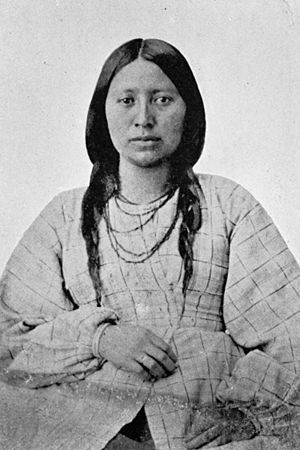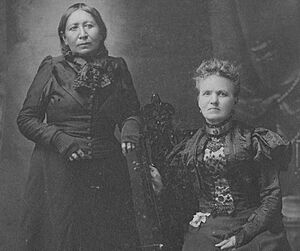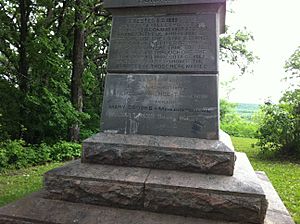Snana facts for kids
Snana (1839–1908), also known as Maggie Brass, was a brave Mdewakanton Dakota woman. She is famous for saving and protecting a 14-year-old German girl named Mary Schwandt. This happened during the Dakota War of 1862.
Maggie and Mary met again in 1894. This led to a special story about them in a newspaper. Maggie also shared her own story of the war. It was published in 1901.
Snana is one of six Dakota "heroes." They are honored at the Faithful Indians’ Monument in Morton, Minnesota.
Contents
Early Life and Learning
Snana was born in Mendota in 1839. Her Dakota name, Snana, means "Tinkling" or "Ringing Sound."
She and her mother were part of the Kaposia band of Mdewakanton Dakota. Snana lived with some of her relatives who were of mixed heritage. She also stayed with the family of Dr. Thomas Smith Williamson. Snana later said the Williamson family taught her about Christianity.
From 1849 to 1852, Snana went to Williamson's Presbyterian mission school. It was in Kaposia village. There, she learned to read, write, and speak English very well. Snana went to school even though some villagers disagreed. They felt the school used money meant for the Mdewakantons unfairly. This money was from the Treaty of 1837.
In 1853, Snana and her mother moved to the Lower Sioux Indian Reservation. This move was part of the Treaty of Mendota from 1851. Their old home was near present-day South St. Paul. Their new home was on the Minnesota River.
In 1854, when she was 15, Snana married Wakinyanwaste (Good Thunder). He gave gifts to her mother, as was the Dakota custom. But Snana wanted to marry in a church. They were married at the Episcopal mission.
In 1861, Snana and her husband became the first Dakota people to be confirmed as Christians. This happened at the Mission of St. John, their Episcopal church. After this, they were known as Maggie and Andrew Good Thunder. Some people made fun of them for their new faith. Maggie was often seen reading her prayer book.
Snana's Role in the Dakota War
In August 1862, Maggie and Andrew Good Thunder's oldest daughter, Lydia, died. She was seven years old. Maggie was very sad. Soon after, she heard about the start of the Dakota War of 1862. Her band's leader, Chief Little Crow, had ordered the first attacks.
Saving Mary Schwandt
Maggie heard from an uncle that a "nice looking girl" had been captured. Maggie and her mother decided to trade their pony for the girl. The captive was 14-year-old Mary Schwandt. Mary had been captured while trying to escape from New Ulm.
Mary Schwandt later said she thought her captor, a young Dakota man, would shoot her. But then Maggie and her mother stepped in to "buy" her.
Maggie Good Thunder sent her mother to make the trade. Maggie later explained: "When she brought this girl, Mary Schwandt, she was much larger than my daughter who died. But my heart was so sad. I wanted to take any girl then. I wanted to keep this girl to have her in place of the one I lost. So I loved her and felt sorry for her. She was as dear to me as my own daughter."
Keeping Mary Safe
In the weeks that followed, some Dakota warriors threatened white captives. Maggie and her mother hid Mary under blankets and buffalo robes. They told the warriors that Mary had run away. Maggie was determined to protect Mary. She thought: "If they were to kill my girl, they must kill me first. I had two of my own children with me. But I cared for this girl just as much as for them."
Maggie dressed Mary in Dakota clothes and made her beaded moccasins. She thought this would keep Mary safer. But if they heard American soldiers were coming, Maggie told Mary to change back into her own clothes. Maggie stayed with Mary all the time to protect her. Her mother also helped.
Mary was not harmed after Maggie protected her. But one night, some drunken Dakota men tried to drag Mary from her tent. Maggie woke up and chased them away. Mary said she called Maggie her "Indian mother." Mary knew Maggie spoke English well. But they rarely spoke English so other Dakota people would not get suspicious. Mary also helped care for Maggie's two young children.
On September 23, 1862, Chief Little Crow was defeated at the Battle of Wood Lake. Maggie dug a hole in her tent. She hid Mary and her two children in the hole. She covered it with poles and sat on them. This protected them while their camp was in chaos. Many of Little Crow's followers planned to escape to Canada.
Maggie was happy when Colonel Henry Hastings Sibley and his army arrived on September 25, 1862. But she was sad to say goodbye to Mary at Camp Release on September 26. She remembered: "When I gave this dear child to the soldiers, my heart ached. But I knew I had done something right. I did not see her or know where she was for 32 years, until 1894."
Life After the War
After the war, Maggie and Andrew Good Thunder lived at a camp at Fort Snelling. Their other two children died there.
In 1863, most Dakota people were forced to leave Minnesota. They were moved to Crow Creek Indian Reservation in South Dakota. However, Andrew Good Thunder became a scout for the army. Maggie was allowed to move to Faribault, Minnesota.
Around 1865, Snana and Andrew Good Thunder separated. Snana moved to the Santee Sioux Reservation in Nebraska. Many Dakota people had moved there after Crow Creek.
At the Santee Reservation, she married Charles Brass. He was a respected Dakota scout. She then became known as Maggie Brass. They had one son and two adopted daughters. Charles died in 1894 from injuries he received while serving in the army.
Meeting Mary Again
In 1894, a historian named Return Ira Holcombe published Mary Schwandt-Schmidt's story. In her story, Mary included a message for Snana: "I hear she is somewhere in Nebraska. But wherever you are, Maggie, I want you to know that the little German girl you helped so often still loves you. She prays God to bless you and reward you."
The leader at the Santee Sioux Reservation saw the article. She showed it to Maggie. Maggie Brass wrote a letter to Mary. The two women started writing to each other often. Soon, Maggie traveled to Saint Paul to meet Mary. Snana said their reunion was "just as if I went to visit my own child." They became very close. Maggie visited Mary at her home once a year.
Return Ira Holcombe wrote another article about their reunion. He also encouraged Maggie to share her own story.
"Narration of a Friendly Sioux"
Snana wrote her story in English in 1894. Her first title was "The Story of Maggie Brass and Her Experience in the Sioux Outbreak."
But when it was published, the title was "Narration of a Friendly Sioux: By Snana, the Rescuer of Mary Schwandt." Holcombe likely changed the title and used her Dakota name. He edited Snana's story, which was published in 1901.
In 1901, Snana and Mary Schmidt were invited to visit Minnesota Governor Samuel Rinnah Van Sant in Saint Paul.
Honored at the Monument
Maggie Brass died on April 24, 1908. After her death, Snana’s name was added to the Faithful Indians’ Monument. This monument is in Morton, Minnesota.
The monument was built in 1899. It honors "full-blood Sioux Indians" who stayed loyal and saved at least one white person. Snana was chosen as one of six Dakota "heroes" to be honored.




